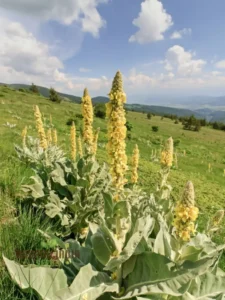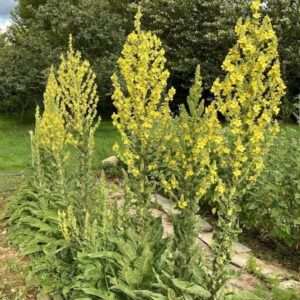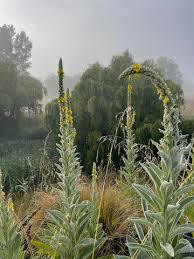Common mullein, is a versatile medicinal plant found across Asia, Europe, and especially widespread in the United States. Revered for its traditional uses in treating respiratory conditions, wounds, skin disorders, and more, this fuzzy-leaved herb has recently gained renewed interest for its anti-inflammatory, antimicrobial, and potential anticancer properties.
General Information
Names and Scientific Classification
Name: Mullein
Scientific name: Verbascum thapsus

Natural Characteristics
Common mullein is a biennial plant that grows widely across the United States. Its leaves are soft and fuzzy, resembling lamb’s ear. During the first year of growth, the large leaves form a rosette near the base. In the second spring, a tall stalk emerges that can reach up to 1.2 meters or more. Yellow flowers with five petals bloom at the top of the stalk. These flowers bloom from June to September and have a faint honey-like scent.
Distribution, Harvesting, and Processing
Common mullein is cultivated throughout the United States. The leaves are harvested from the lower part of the plant and used either fresh or dried for medicinal purposes.
Usable Parts
The root, flowers, and leaves of the mullein plant are used medicinally.
Chemical Composition
The plant contains various compounds including polysaccharides, iridoids and lignin glycosides, flavonoids, saponins, phenylethanoids, and essential oils.
- Saponins: Known for anti-inflammatory, analgesic, and anti-tumor properties.
- Flavonoids: Possess antioxidant and anti-inflammatory effects.
- Phenylethanoids: Glycosides with anti-inflammatory, antioxidant, and antiviral activities.
- Iridoids: Known for anti-inflammatory effects.
Several studies have focused on the activities of verbascoside (found in many plant parts and also in Verbena), as well as mucilage and thapsic acid found in the flowers. Verbascoside may inhibit nitric oxide synthesis, contributing to antispasmodic effects.

Uses
Traditional Medicine
Common mullein has been used to manage respiratory disorders such as asthma, cough, tuberculosis, and related conditions. It has also been used in various forms to treat hemorrhoids, burns, bruises, and gout. It can be administered orally, applied topically, or used for inhalation.
In the Appalachian region of the United States, it has been used to treat colds, and the root is boiled as a remedy for lung cancer. The leaves have been applied externally to soften and protect the skin, while oil extracted from the flowers is used to treat laryngotracheobronchitis. The saponins, mucilage, and tannins in the flowers and leaves may contribute to its soothing properties and use as a cough suppressant.
Modern Medicine
There are no clinical studies confirming the therapeutic effects of common mullein. However, animal research data suggest antibacterial, cytotoxic, and anti-inflammatory properties.
Anti-inflammatory Activity
Animal studies show that mullein extracts can promote wound healing.
Antibacterial and Anthelmintic Activity
In vitro studies show that common mullein is effective against several viruses (including influenza and herpes simplex) and common human pathogens. It has shown effects on both Gram-positive and Gram-negative bacteria (e.g., Klebsiella pneumoniae, Staphylococcus aureus, Staphylococcus epidermidis, and Escherichia coli).
The methanolic extract of V. thapsus has shown anthelmintic activity, with parasite-killing rates comparable to albendazole.
Ear drops containing extracts from mullein have been used to treat ear infections in animals.
Anticancer Activity
In vitro data indicate that mullein extract has activity against various cancer cell lines.
Antiviral Activity
Laboratory studies show antiviral effects against influenza A and herpes. Another study demonstrated that combining mullein with amantadine enhances its antiviral effects against influenza.
Other Activities
Diuretic effects of mullein extract have been demonstrated in mice.
The plant also exhibits cholinesterase inhibition and antioxidant activity.
Dosage and Administration
There are no clinical studies on precise dosage; however, traditional usage suggests 3 to 4 grams of flowers per day, and 15 to 30 ml of fresh leaves or 2 to 3 grams of dried leaves.
Oil extracted from the flowers or leaves is used as a remedy for earaches, eczema, and other skin conditions.

Precautions
Common mullein may cause contact dermatitis, a skin reaction resulting in itching, rashes, and irritation. People with sensitive skin or prone to allergic reactions should perform a patch test before use.
Only use common mullein for severe earaches or infections under a doctor’s guidance.
There are no studies on the safety or efficacy of mullein or its extracts for pregnant or breastfeeding women, and thus it should not be used in these populations.
Though common mullein originates in the U.S. and possesses various medicinal benefits. Therefore, it should be used cautiously and only under medical advice regarding appropriate dosage and treatment conditions.

